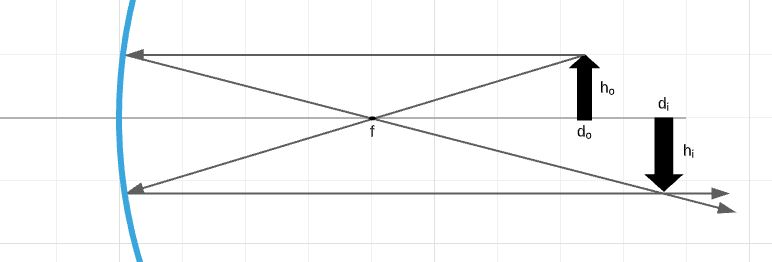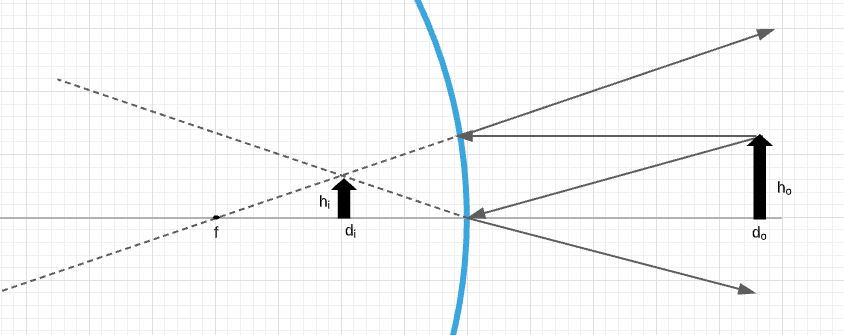All Solutions
Page 473: Section Review
– the mirror is concave, which means that $f>0$
– image is upright, which means that $h_i>0$
– image is larger than object, which means that $M=-frac{d_i}{d_o}>1$
$$d_i<-d_o$$
The position of object is real, which means that the position of image is **virtual**.
$$frac{1}{d_o}+frac{1}{d_i}=frac{1}{f}$$
Using previous equations we can get:
$$frac{1}{d_i}<0/+frac{1}{d_o}$$
$$frac{1}{d_o}+frac{1}{d_i}<frac{1}{d_o}$$
And further combining them:
$$frac{1}{f}<frac{1}{d_o}$$
Which finally means:
$$boxed{d_o<f}$$
Image will be virtual.
From this, we know that we can write this like $frac{1}{d_{i}}<0$. We will add $frac{1}{d_{o}}$ to both sides, and compare that with the mirror equation to find the position of the object relative to the focal length
$$
begin{align*}
frac{1}{d_{i}}&<0 / + frac{1}{d_{o}}\
frac{1}{d_{o}}+ frac{1}{d_{i}} &< frac{1}{d_{o}}\
frac{1}{f} &= frac{1}{d_{o}}+ frac{1}{d_{i}}\
frac{1}{f} &< frac{1}{d_{o}}\
d_{o} &< f
end{align*}
$$
So, the position of the object is between the mirror and the focal point.
$$frac{1}{d_o}+frac{1}{d_i}=frac{1}{f}$$
Where $f$ is positive for the concave mirror.
From the previous equation we can express $d_i$:
$$frac{1}{d_i}=frac{1}{f}-frac{1}{d_o}$$
$$frac{q}{d_i}=frac{d_o-f}{fd_o}$$
And finally:
$$d_i=frac{fd_o}{d_o-f}$$
$$d_i=frac{9cdot 20}{20-9}$$
$$d_i=16.36,,rm{cm}$$
$$M=-frac{d_i}{d_o}$$
Inserting values:
$$M=-frac{16.36}{20}$$
$$boxed{M=-0.82}$$
$$frac{1}{d_o}+frac{1}{d_i}=frac{1}{f}$$
From the previous equation we can express $d_o$:
$$frac{1}{d_o}=frac{1}{f}-frac{1}{d_i}$$
$$frac{q}{d_o}=frac{d_i-f}{fd_i}$$
And finally:
$$d_o=frac{fd_i}{d_i-f}$$
$$d_o=frac{12cdot 22.3}{22.3-12}$$
$$boxed{d_o=26,,rm{cm}}$$
The diagram below is in scale of $1:3$, We can see that the image is real and inverted, so its height will be lesser than zero. Also, from diagram we can see that height is about $h_{i}= -1.2 hspace{0.5mm} mathrm{cm}$, or in real size $h_{i}= -3.6 hspace{0.5mm} mathrm{cm}$. For the position of the image, we can see that the image is at $8.0 hspace{0.5mm} mathrm{cm}$ and about $3/4$ of the square. So in the total, the position of the image is $d_{i}=8.75 hspace{0.5mm} mathrm{cm}$, or in real size $d_{i}=26.25 hspace{0.5mm} mathrm{cm}$.
begin{align*}
frac{1}{d_{o}}+ frac{1}{d_{i}}&= frac{1}{f}\
frac{1}{d_{i}}&= frac{1}{f} – frac{1}{d_{o}}\
frac{1}{d_{i}}&= frac{d_{o} – f}{f hspace{0.5mm} d_{o}} \
d_{i}&= frac{f hspace{0.5mm} d_{o}}{d_{o} – f}\
d_{i}&= frac{12.0 hspace{0.5mm} mathrm{cm} cdot 22.0 hspace{0.5mm} mathrm{cm}}{22.0 hspace{0.5mm} mathrm{cm} – 12.0 hspace{0.5mm} mathrm{cm}}\
d_{i}&= 26.4 hspace{0.5mm} mathrm{cm}
end{align*}
So, the position of the image is [ framebox[1.1width]{$ therefore d_{i} = 26.4 hspace{0.5mm} mathrm{cm} $}]
Now, we are going to use the magnification equation to find the height of the image
begin{align*}
M&=- frac{d_{i}}{d_{o}}= frac{h_{i}}{h_{o}} \
frac{h_{i}}{h_{o}} &= – frac{d_{i}}{d_{o}} \
h_{i} &=- h_{o} frac{d_{i}}{d_{o}} \
h_{i} &=- 3.0 hspace{0.5mm} mathrm{cm} hspace{0.5mm} frac{26.4 hspace{0.5mm} mathrm{cm}}{22.0 hspace{0.5mm} mathrm{cm}} \
h_{i} &=- 3.0 hspace{0.5mm} mathrm{cm} cdot 1.2 \
h_{i} &=- 3.6 hspace{0.5mm} mathrm{cm}
end{align*}
So, the height of the image is [ framebox[1.1width]{$ therefore h_{i} = -3.6 hspace{0.5mm} mathrm{cm} $}]

$$
h_{i} = -3.6 hspace{0.5mm} mathrm{cm}
$$
The diagram below is in scale of $1:3$. We can see that the image is upright and virtual, so its height will be greater than zero, but the position willl be lesser than zero. Also, from diagram we can see that height is about $h_{i}= 0.6 hspace{0.5mm} mathrm{cm}$, or in real size $h_{i}= 1.8 hspace{0.5mm} mathrm{cm}$. For the position of the image, we can see that the image is at $-2.0 hspace{0.5mm} mathrm{cm}$. So the position of the image in real size is $d_{i}=6.0 hspace{0.5mm} mathrm{cm}$. Also, on the diagram below, the big square has sides of length $1.0 hspace{0.5mm} mathrm{cm}$.
begin{align*}
frac{1}{d_{o}}+ frac{1}{d_{i}}&= frac{1}{f}\
frac{1}{d_{i}}&= frac{1}{f} – frac{1}{d_{o}}\
frac{1}{d_{i}}&= frac{d_{o} – f}{f hspace{0.5mm} d_{o}} \
d_{i}&= frac{f hspace{0.5mm} d_{o}}{d_{o} – f}\
d_{i}&= frac{-12.0 hspace{0.5mm} mathrm{cm} cdot 14.0 hspace{0.5mm} mathrm{cm}}{14.0 hspace{0.5mm} mathrm{cm} + 12.0 hspace{0.5mm} mathrm{cm}}\
d_{i}&= -6.5 hspace{0.5mm} mathrm{cm}
end{align*}
So, the position of the image is [ framebox[1.1width]{$ therefore d_{i} = -6.5 hspace{0.5mm} mathrm{cm} $}]
Now, we are going to use the magnification equation to find the height of the image
begin{align*}
M&=- frac{d_{i}}{d_{o}}= frac{h_{i}}{h_{o}} \
frac{h_{i}}{h_{o}} &= – frac{d_{i}}{d_{o}} \
h_{i} &=- h_{o} frac{d_{i}}{d_{o}} \
h_{i} &=- 4.0 hspace{0.5mm} mathrm{cm} frac{-6.5 hspace{0.5mm} mathrm{cm}}{14.0 hspace{0.5mm} mathrm{cm}} \
h_{i} &=- 4.0 hspace{0.5mm} mathrm{cm} cdot (-0.46) \
h_{i} &= 1.85 hspace{0.5mm} mathrm{cm}
end{align*}
So, the height of the image is [ framebox[1.1width]{$ therefore h_{i} =1.85 hspace{0.5mm} mathrm{cm} $}]

$$
h_{i} =1.85 hspace{0.5mm} mathrm{cm}
$$
$$frac{h_i}{h_o}=-frac{d_i}{d_o}$$
And we can get:
$$d_i=-d_ofrac{h_i}{h_o}$$
$$d_i=-16.4cdot frac{2.8}{6}$$
$$d_i=-7.65,,rm{cm}$$
$$frac{1}{d_o}+frac{1}{d_i}=frac{1}{f}$$
From the previous equation we can express $f$:
$$frac{1}{f}=frac{d_i-d_o}{d_id_o}$$
And finally:
$$f=frac{d_id_o}{d_i-d_o}$$
$$f=frac{16.4cdot 7.65}{7.65-16.4}$$
$$f=14.34,,rm{cm}$$
$$r=2|f|$$
Inserting values:
$$r=2cdot 14.34$$
$$boxed{r=28.7,,rm{cm}}$$
begin{align*}
M&=- frac{d_{i}}{d_{o}} \
d_{o}&= – frac{d_{i}}{M}\
d_{o}&= – frac{-12 hspace{0.5mm} mathrm{cm}}{ frac{2}{3}}\
d_{o}&= frac{3 cdot 12 hspace{0.5mm} mathrm{cm}}{ 2}\
d_{o}&= 18 hspace{0.5mm} mathrm{cm}
end{align*}
Now, we can find the focal length of the mirror with the previous information and the mirror equation
begin{align*}
frac{1}{f} &= frac{1}{d_{o}}+ frac{1}{d_{i}}\
frac{1}{f} &= frac{d_{o}+d_{i}}{ d_{o} hspace{0.5mm} d_{i}}\
frac{1}{f} &= frac{d_{o}+d_{i}}{ d_{o} hspace{0.5mm} d_{i}}\
f &= frac{ d_{o} hspace{0.5mm} d_{i}}{ d_{o}+d_{i}} \
f &= frac{ 18 hspace{0.5mm} mathrm{cm} hspace{0.5mm}(-12 hspace{0.5mm} mathrm{cm})}{ 18 hspace{0.5mm} mathrm{cm}-12 hspace{0.5mm} mathrm{cm}} \
f&= -36 hspace{0.5mm} mathrm{cm}
end{align*}
The focal length is [ framebox[1.1width]{$ therefore f = -36 hspace{0.5mm} mathrm{cm} $}]
f = -36 hspace{0.5mm} mathrm{cm}
$$
This defect prohibits the mirror from focusing all the incident light from the same location on an object to a precise point.
$$
text{color{#4257b2}The defect is most noticeable for light rays striking the outer edges of the mirror.
$ $
Rays that strike the outer edges of the mirror fail to focus in the same precise location as light rays that strike the inner portions of the mirror.}
$$
text{color{#c34632}Therefore spherical aberration will be less for a mirror whose height is small compared to its radius of curvature }
$$

